
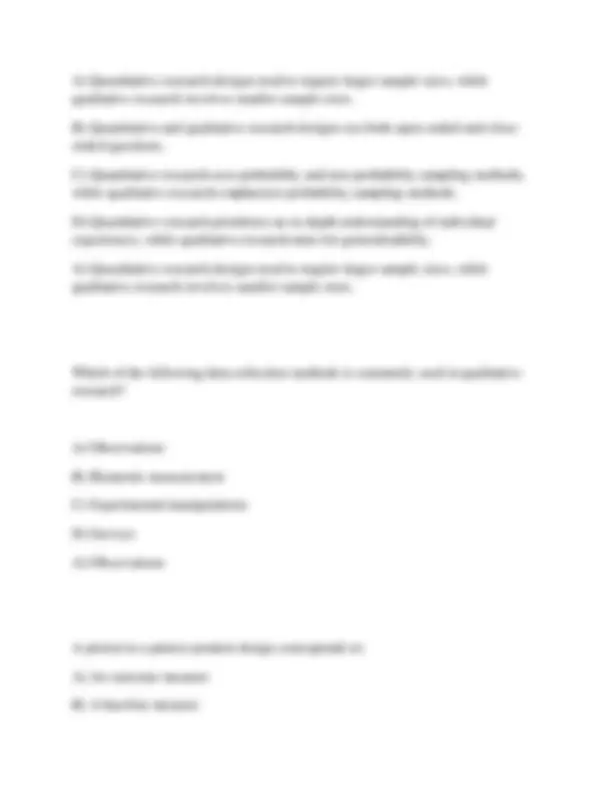
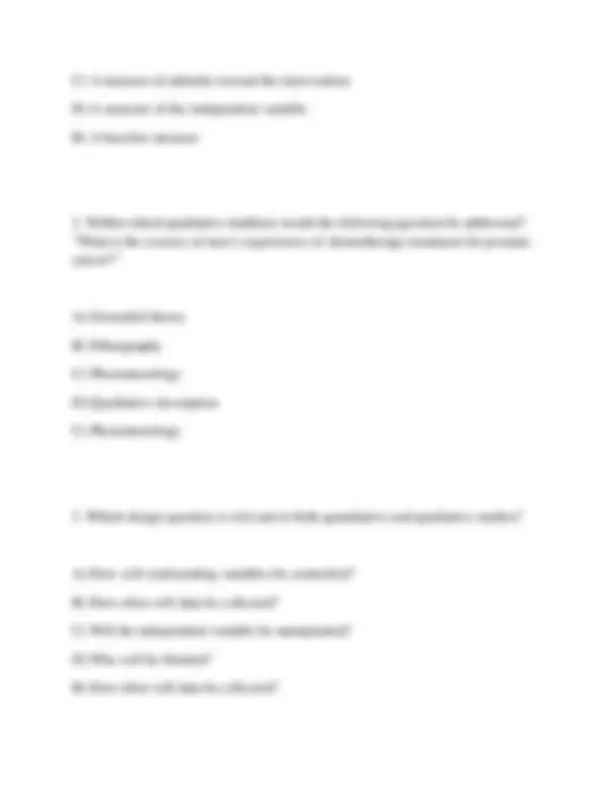
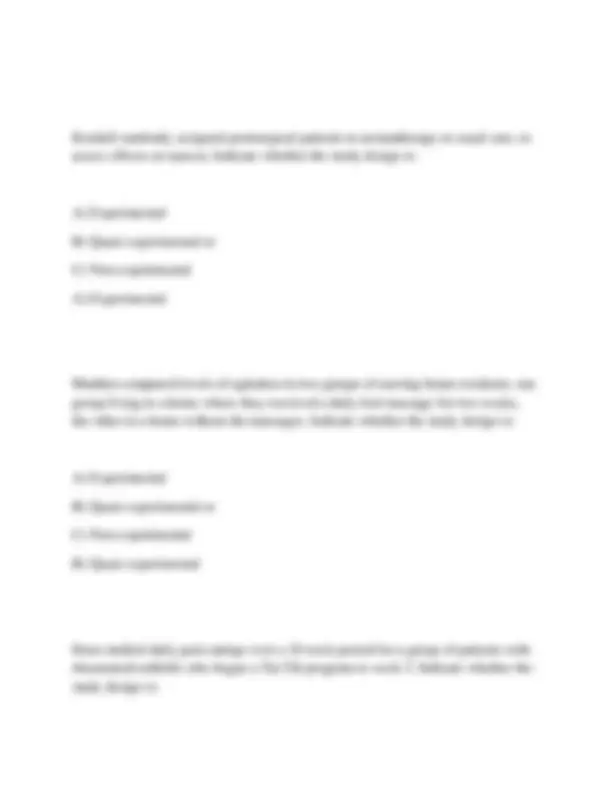
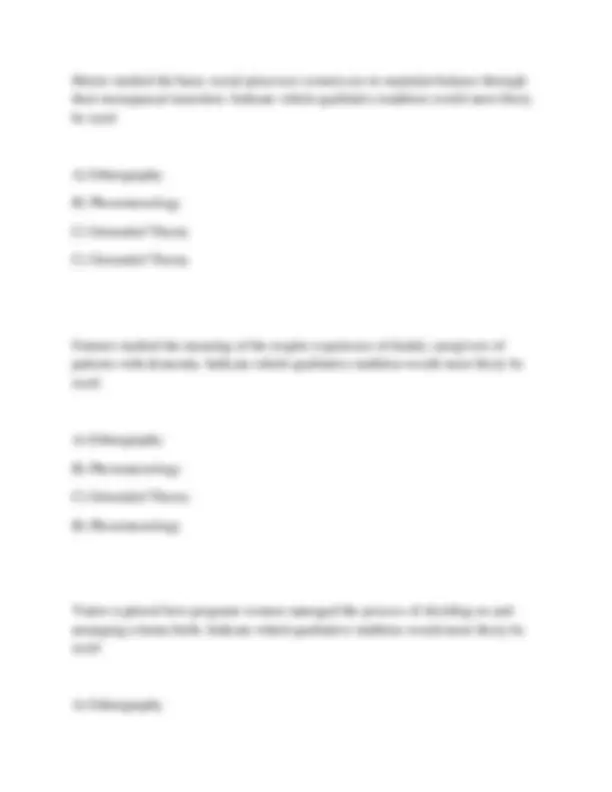
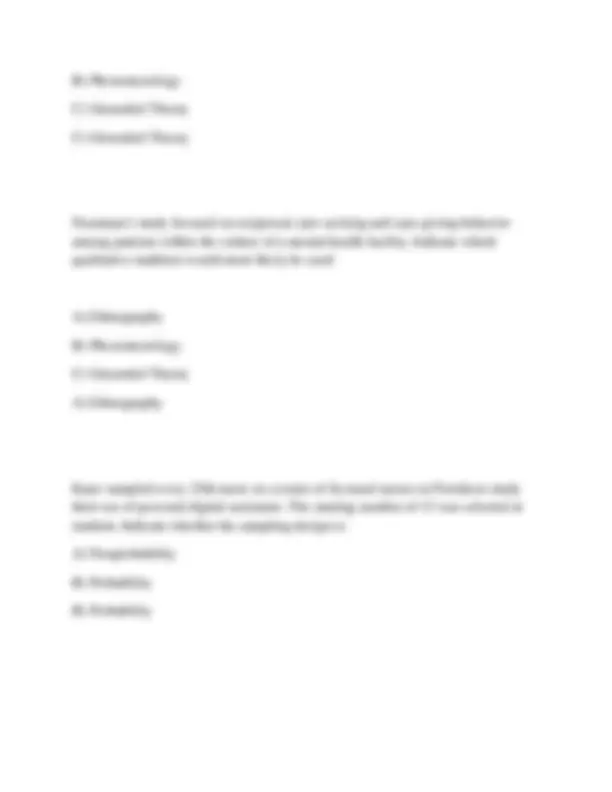
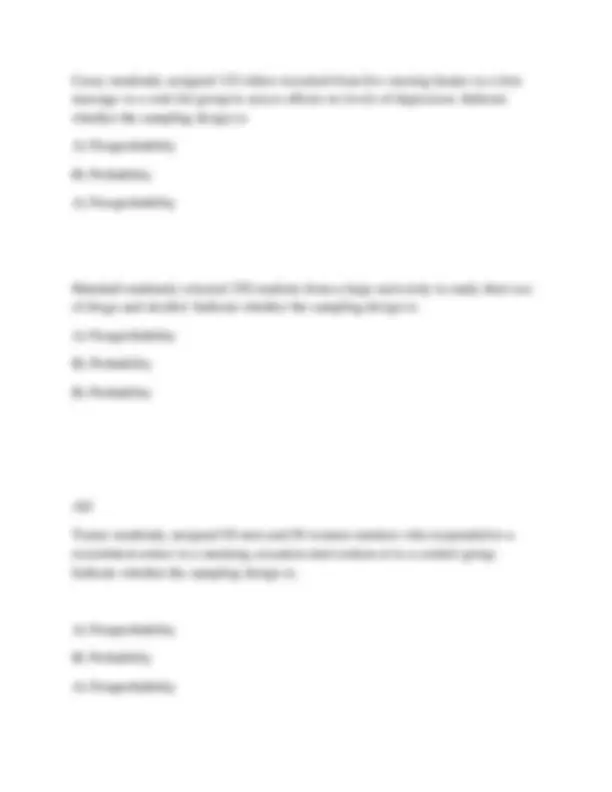
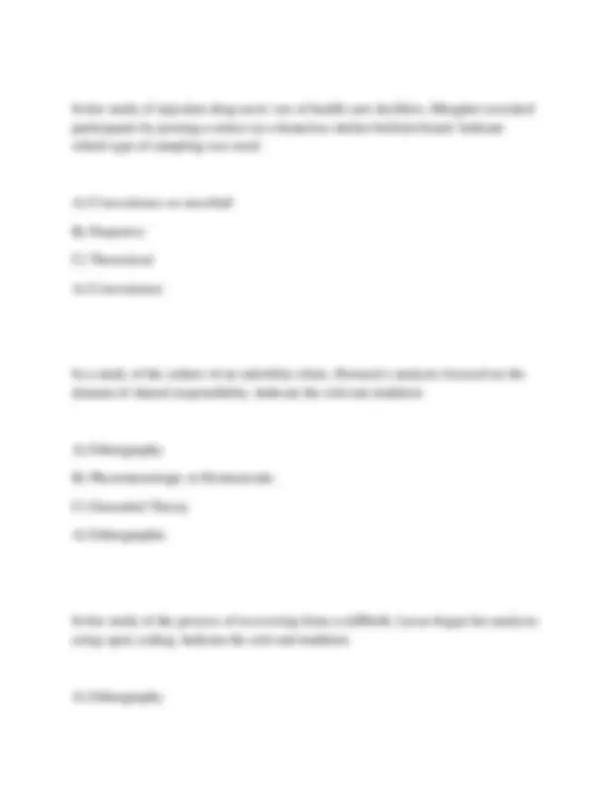
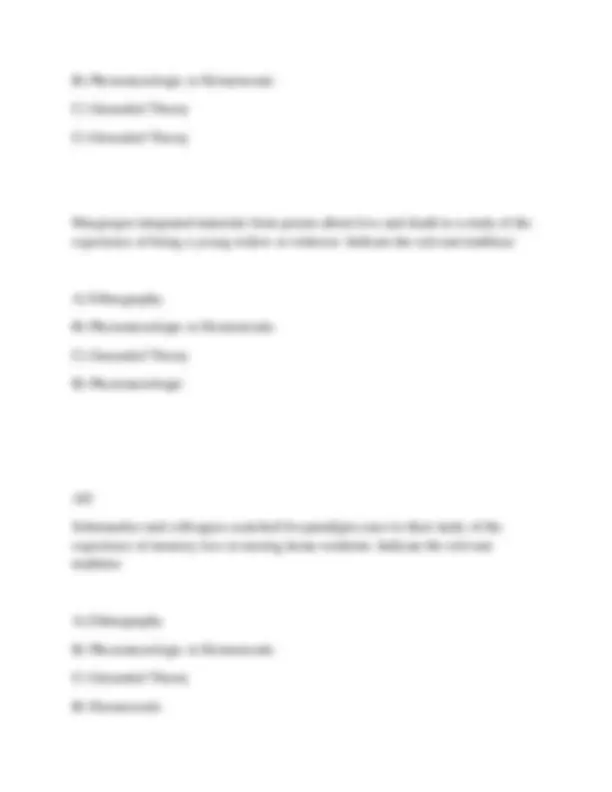
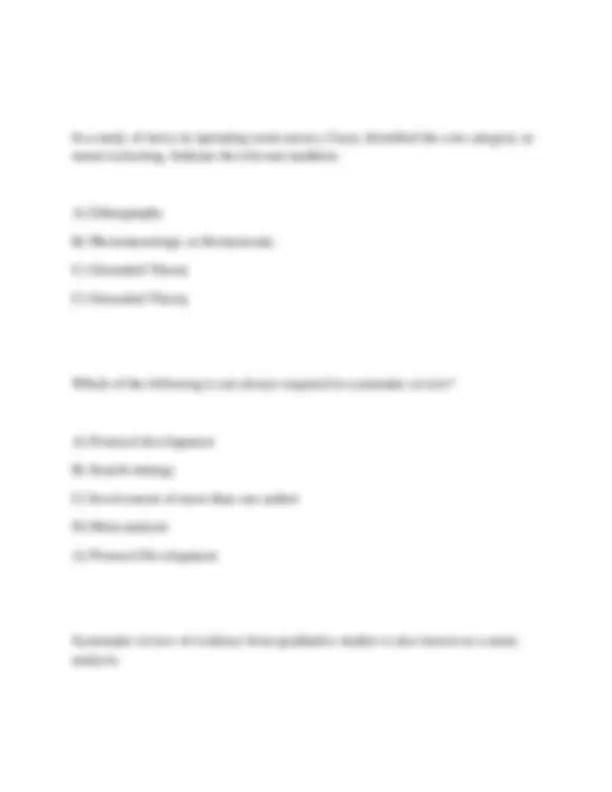
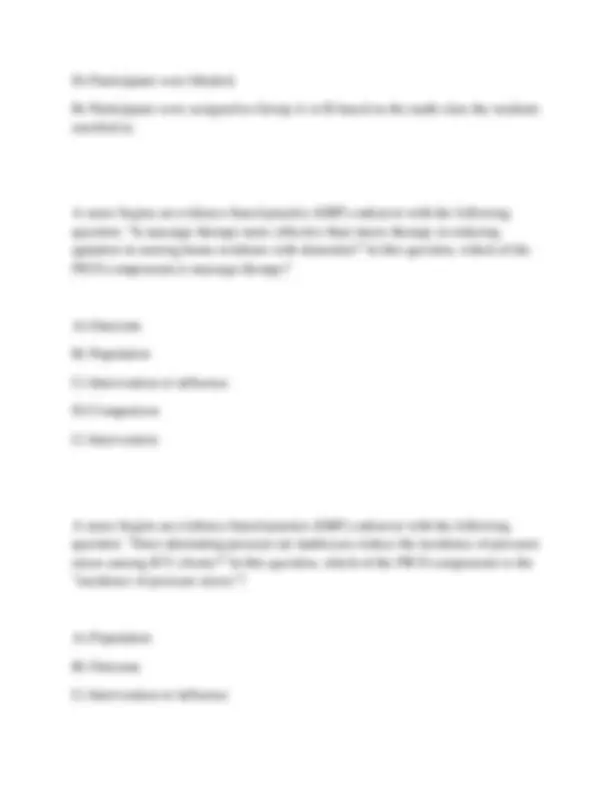
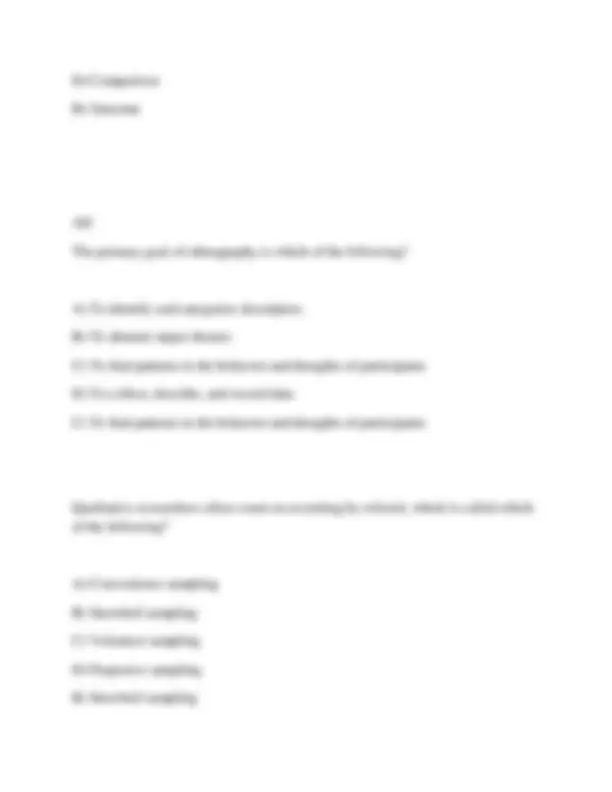
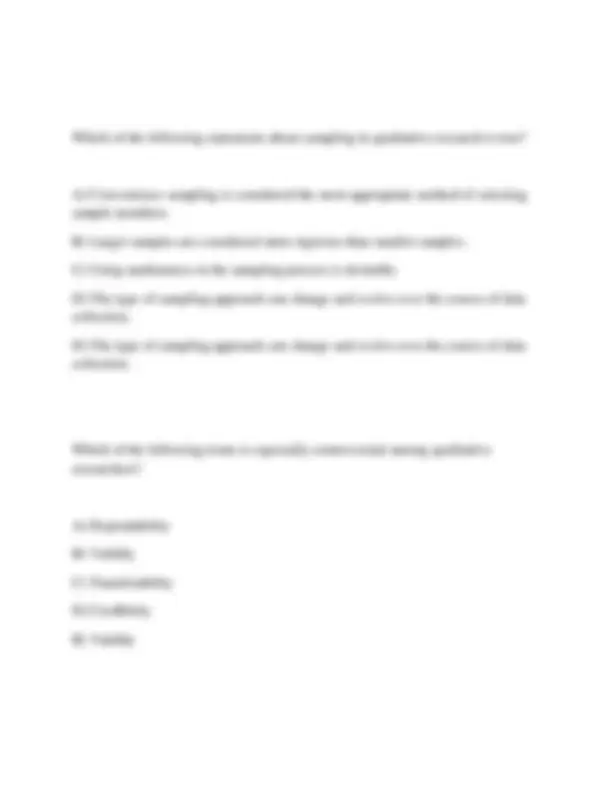
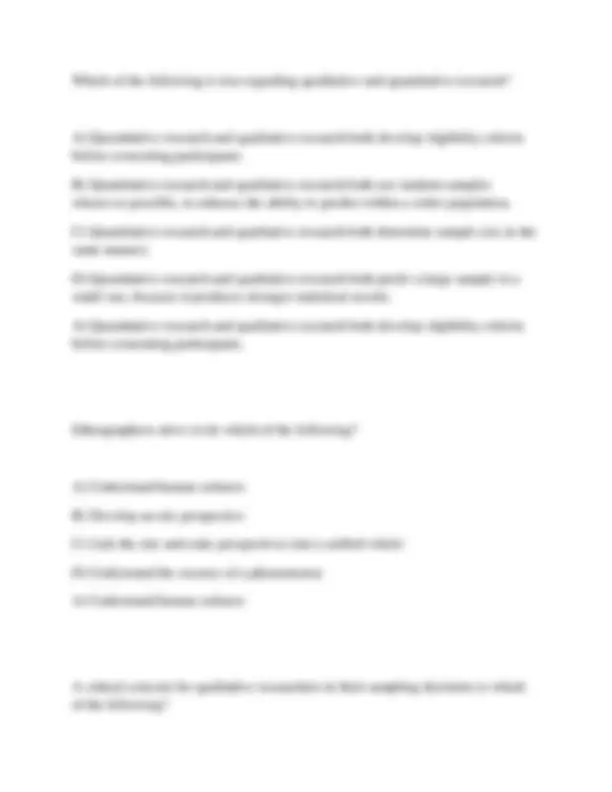
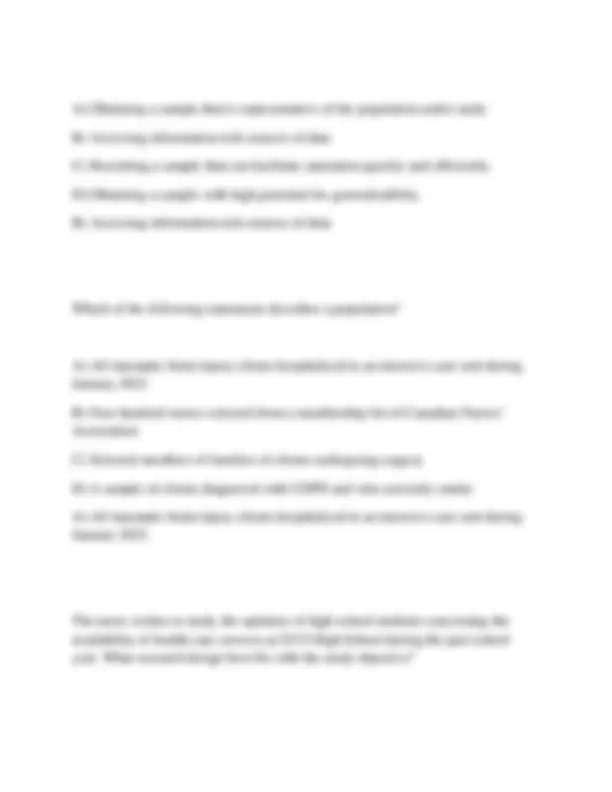
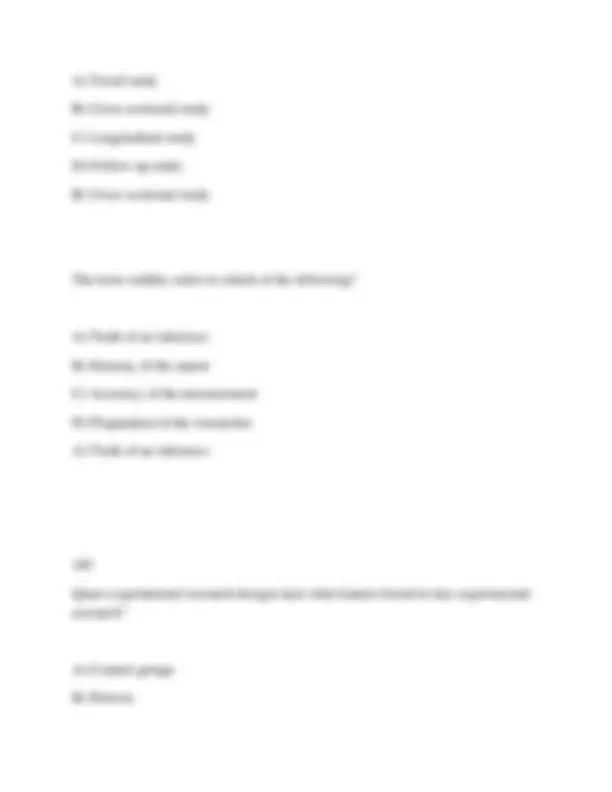
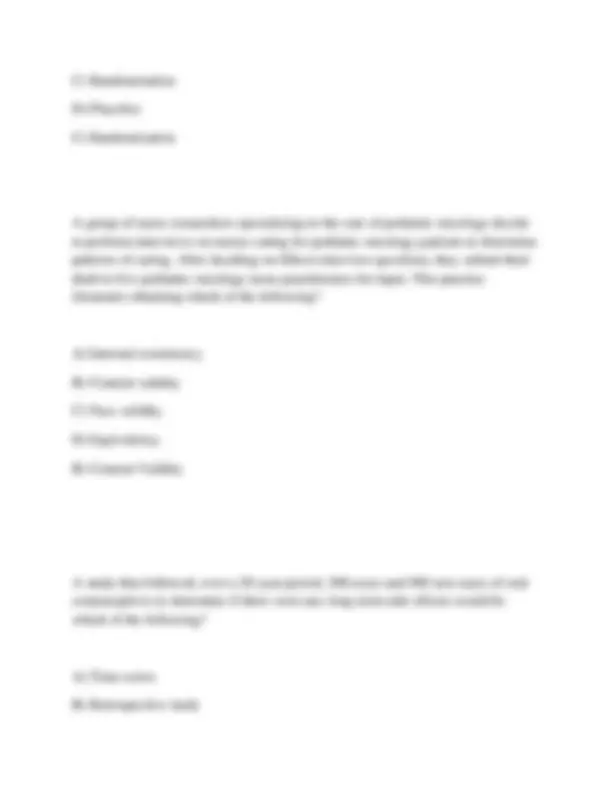
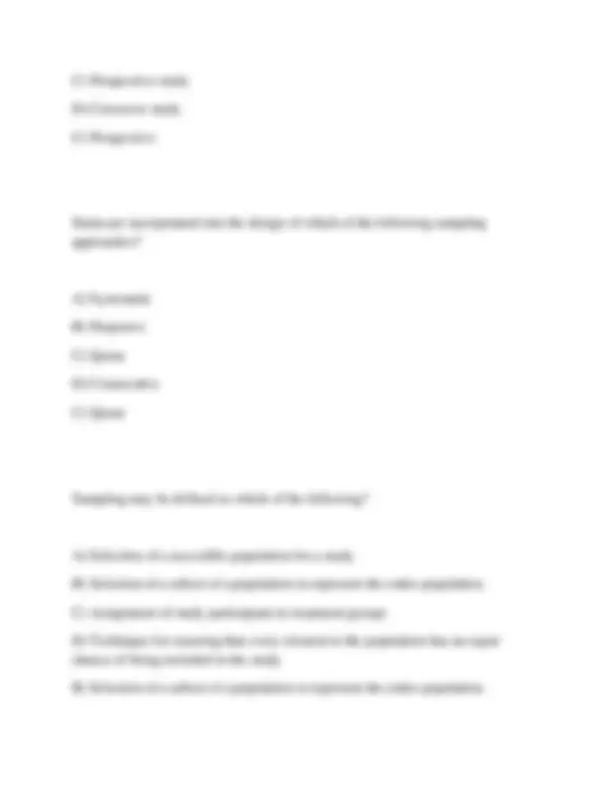
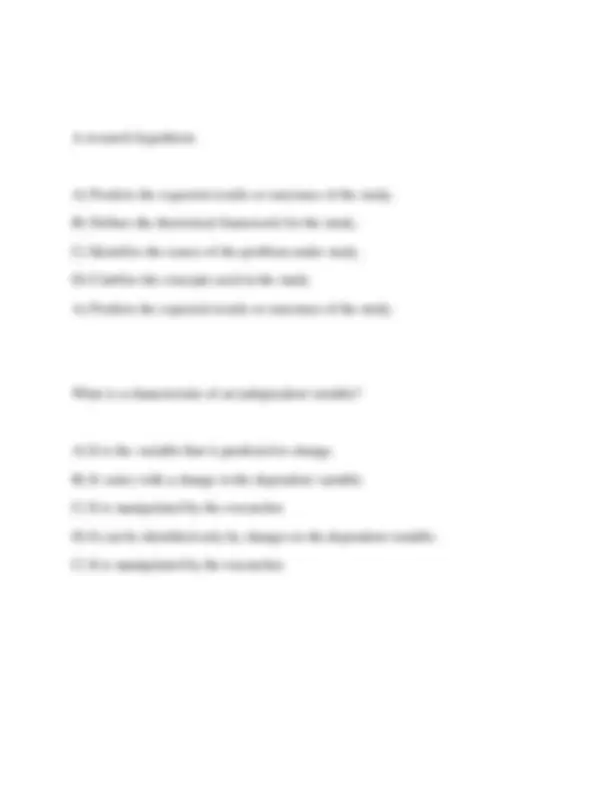
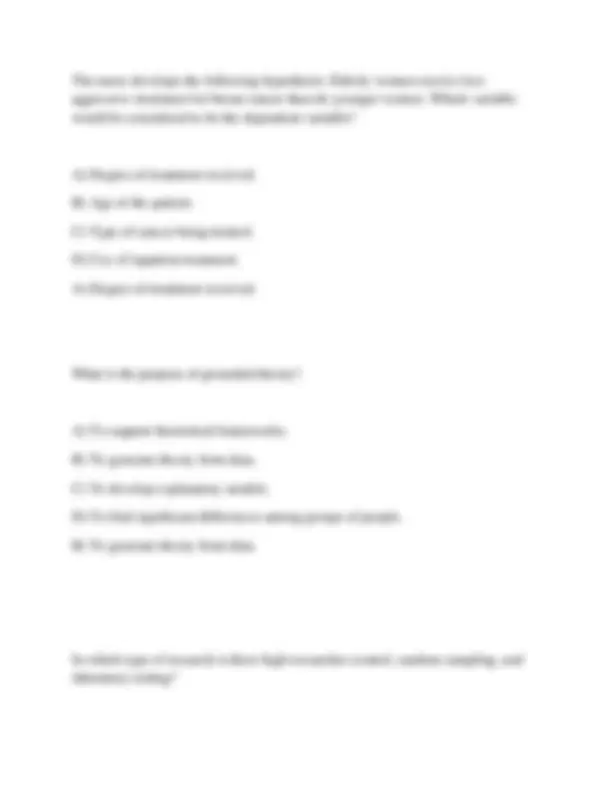
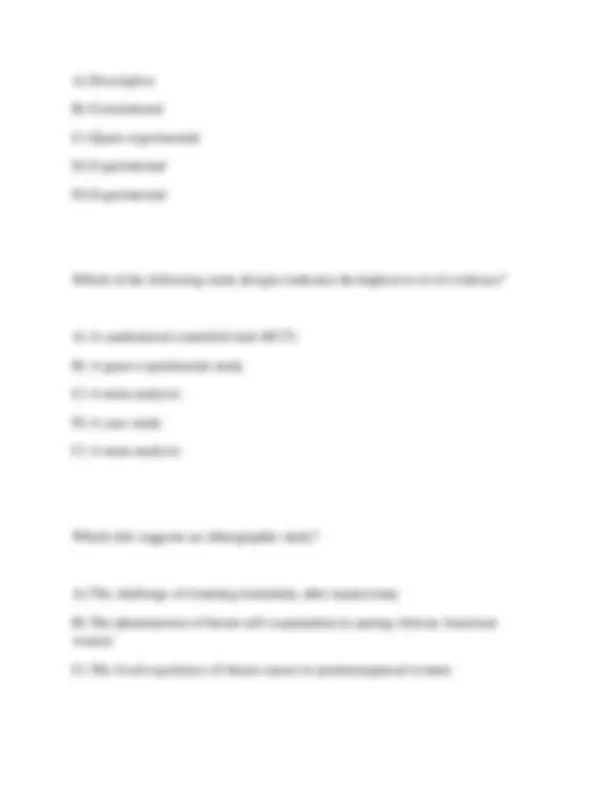
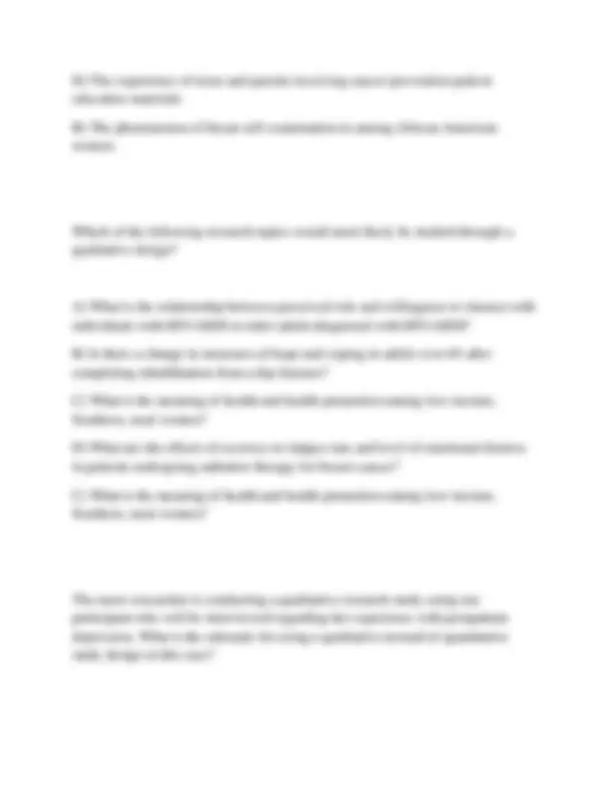
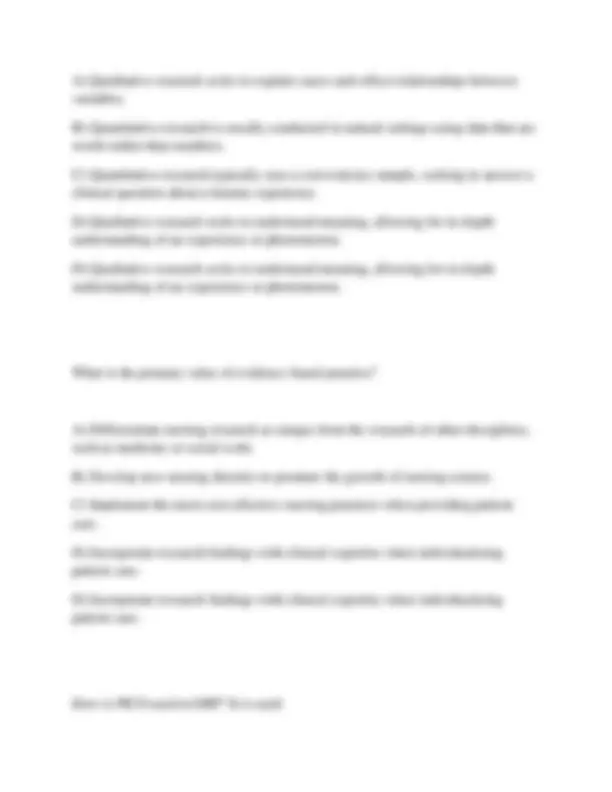
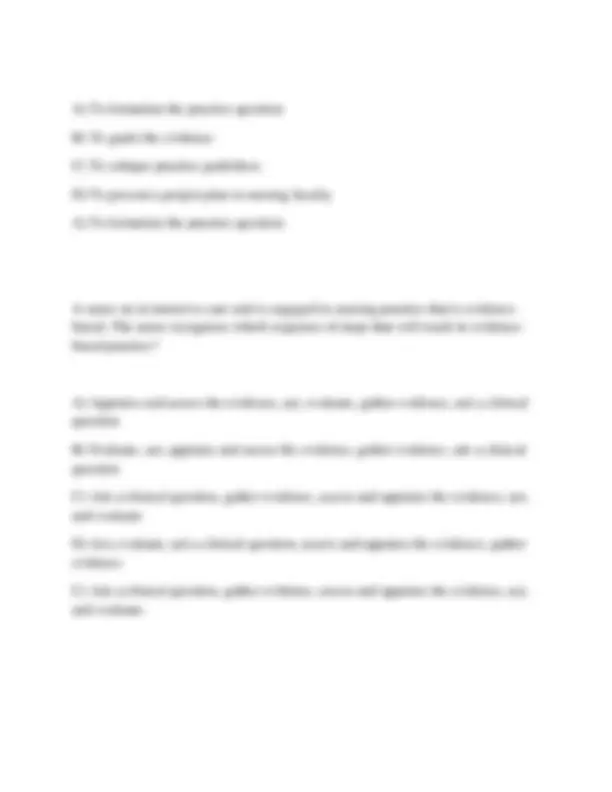
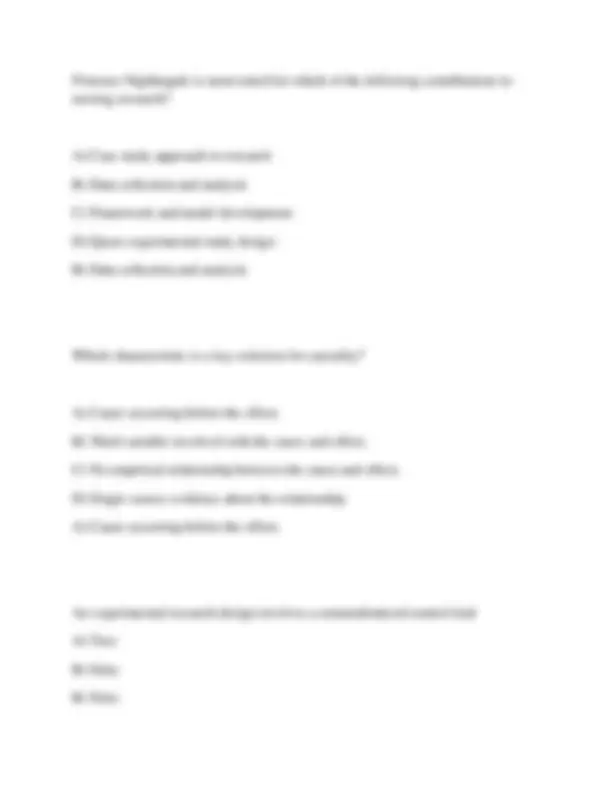
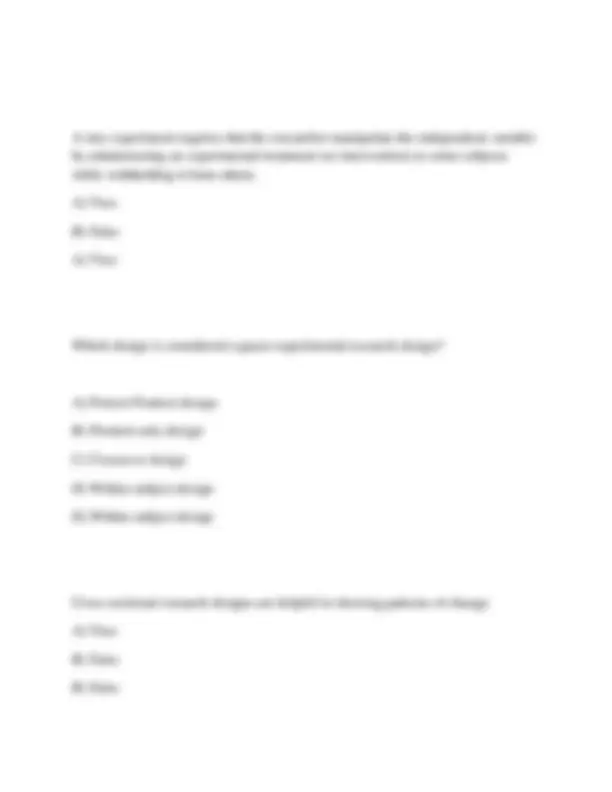
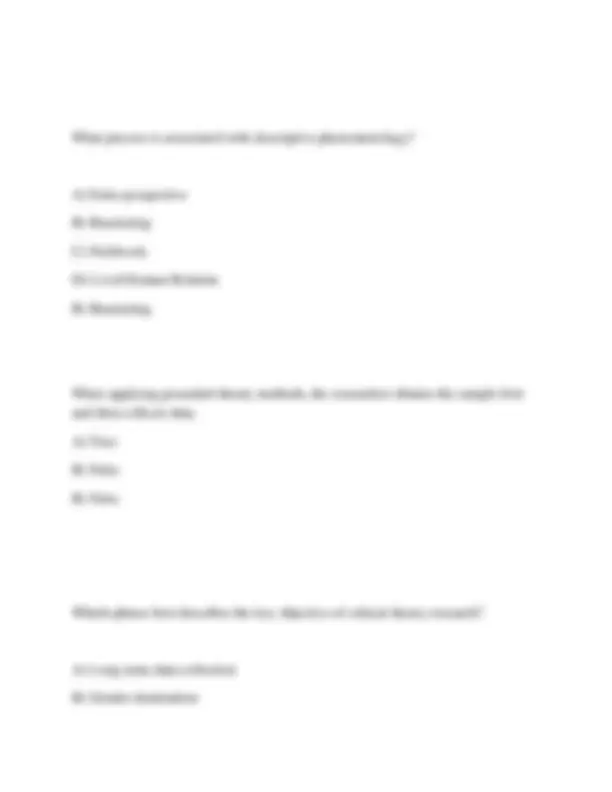
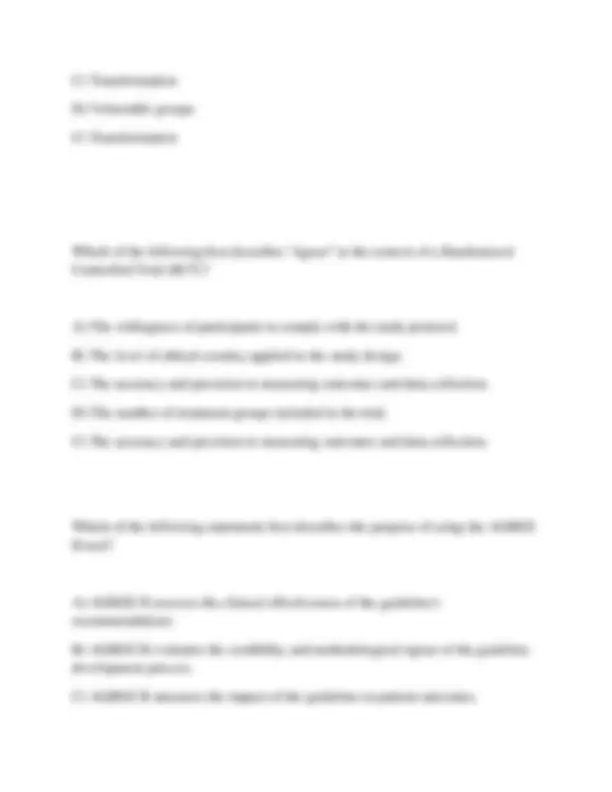
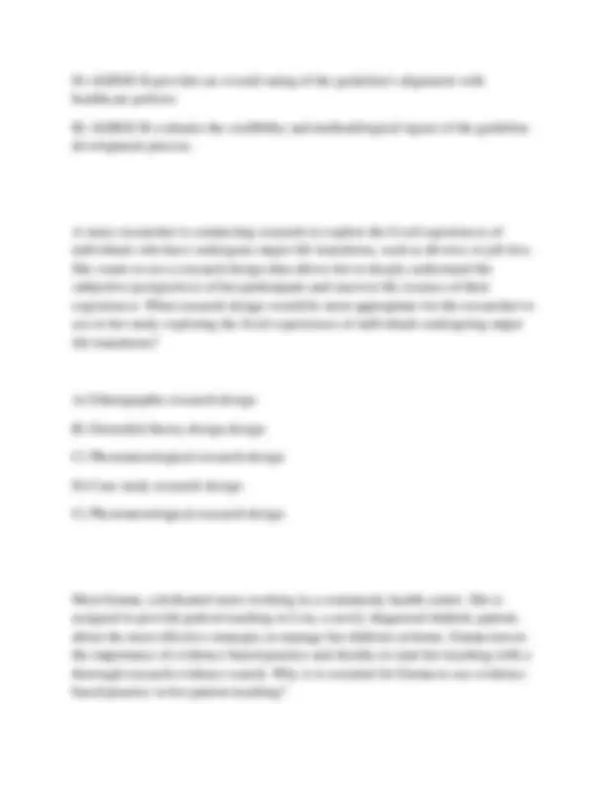
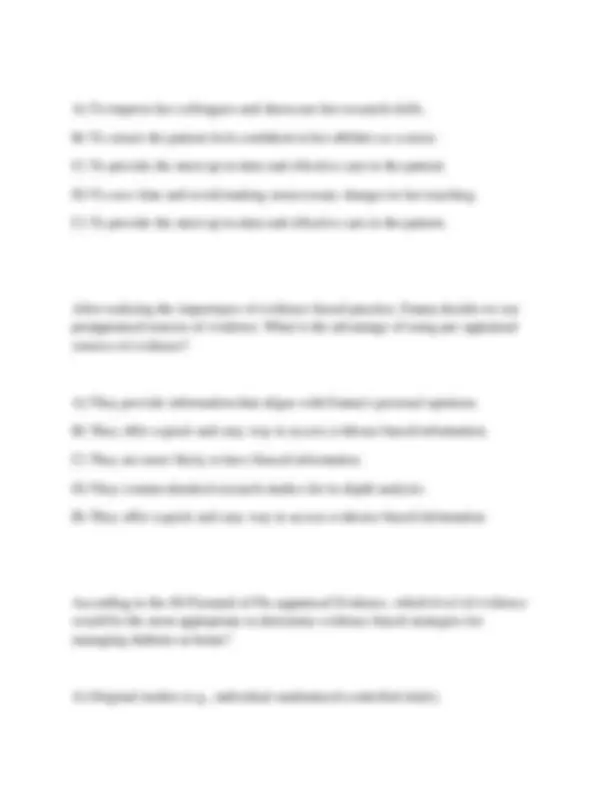
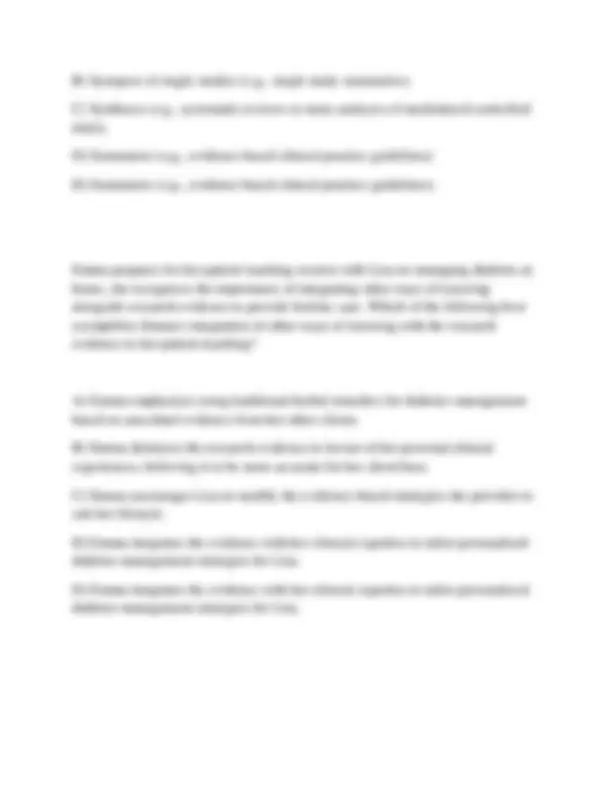



Study with the several resources on Docsity

Earn points by helping other students or get them with a premium plan


Prepare for your exams
Study with the several resources on Docsity

Earn points to download
Earn points by helping other students or get them with a premium plan
Community
Ask the community for help and clear up your study doubts
Discover the best universities in your country according to Docsity users
Free resources
Download our free guides on studying techniques, anxiety management strategies, and thesis advice from Docsity tutors
NSG 620 EVIDENCE BASED PRACTICE AND RESEARCH EXAM 2025-2026 QUESTIONS AND CORRECT ANSWERS GRADED A+
Typology: Exams
1 / 39

This page cannot be seen from the preview
Don't miss anything!
































Which of the following statements best represents a criticism of evidence-based practice?
A) Evidence-based practice is universally applicable and does not require adaptation to different clinical settings.
B) Evidence-based practice can be overly rigid and may not account for individual patient preferences and values.
C) Evidence-based practice promotes excessive reliance on expert opinion and ignores scientific evidence.
D) Evidence-based practice does not prioritize cost-effectiveness and may lead to wasteful healthcare spending.
B) Evidence-based practice can be overly rigid and may not account for individual patient preferences and values.
Which of the following research designs is typically used to establish cause-and- effect relationships in quantitative research?
A) Descriptive longitudinal design
B) Ethnographic design
C) Correlational design
D) Quasi-experimental design
D) Quasi-experimental Design
Which of the following options correctly represents the evidence hierarchy in research, from the highest level of evidence to the lowest?
A) Randomized controlled trials, case-control studies, cohort studies, meta- analysis, expert opinions
B) Systematic reviews, randomized controlled trials, case-control studies, cohort studies, expert opinions
C) Systematic reviews, randomized controlled trials, cohort studies, case-control studies, expert opinions.
D) Randomized controlled trials, meta-analysis, cohort studies, case-control studies, expert opinions
C) Systematic reviews, randomized controlled trials, cohort studies, case-control studies, expert opinions.
Which of the following statements best describes a key difference between quantitative and qualitative research?
C) A measure of attitudes toward the intervention
D) A measure of the independent variable
B) A baseline measure
A) Grounded theory
B) Ethnography
C) Phenomenology
D) Qualitative description
C) Phenomenology
A) How will confounding variables be controlled?
B) How often will data be collected?
C) Will the independent variable be manipulated?
D) Who will be blinded?
B) How often will data be collected?
Kendall randomly assigned postsurgical patients to aromatherapy or usual care, to assess effects on nausea. Indicate whether the study design is:
A) Experimental
B) Quasi-experimental or
C) Non-experimental
A) Experimental
Madden compared levels of agitation in two groups of nursing home residents, one group living in a home where they received a daily foot massage for two weeks, the other in a home without the massages. Indicate whether the study design is:
A) Experimental
B) Quasi-experimental or
C) Non-experimental
B) Quasi-experimental
Dean studied daily pain ratings over a 10 week period for a group of patients with rheumatoid arthritis who began a Tai Chi program in week 5. Indicate whether the study design is:
C) Non-experimental
A) Experimental
Quinn studied the experience of learning about a parents cancer diagnosis, from the perspective of adolescents aged 15 to 18 years. Indicate which qualitative tradition would most likely be used:
A) Ethnography
B) Phenomenology
C) Grounded Theory
B) Phenomenology
Petrik studied end-of-life caregiving for elders living on a Hopi Reservation in Arizona. Indicate which qualitative tradition would most likely be used:
A) Ethnography
B) Phenomenology
C) Grounded Theory
A) Ethnography
Moore studied the basic social processes women use to maintain balance through their menopausal transition. Indicate which qualitative tradition would most likely be used:
A) Ethnography
B) Phenomenology
C) Grounded Theory
C) Grounded Theory
Futterer studied the meaning of the respite experience of family caregivers of patients with dementia. Indicate which qualitative tradition would most likely be used:
A) Ethnography
B) Phenomenology
C) Grounded Theory
B) Phenomenology
Viator explored how pregnant women managed the process of deciding on and arranging a home birth. Indicate which qualitative tradition would most likely be used:
A) Ethnography
Casey randomly assigned 152 elders recruited from five nursing homes to a foot massage or a wait-list group to assess effects on levels of depression. Indicate whether the sampling design is:
A) Nonprobability
B) Probability
A) Nonprobability
Marshall randomly selected 250 students from a large university to study their use of drugs and alcohol. Indicate whether the sampling design is:
A) Nonprobability
B) Probability
B) Probability
Turner randomly assigned 50 men and 50 women smokers who responded to a recruitment notice to a smoking cessation intervention or to a control group. Indicate whether the sampling design is:
A) Nonprobability
B) Probability
A) Nonprobability
Solomon studied circadian rhythms in a sample of 45 pregnant women consecutively admitted to a hospital in the first 6 months of 2016 because of severe preeclampsia. Indicate whether the sampling design is:
A) Nonprobability
B) Probability
A) Nonprobability
Armer explored nightmares in hospitalized children and recruited both boys and girls from different socioeconomic and ethnic backgrounds. Indicate which type of sampling was used:
A) Convenience or snowball
B) Purposive
C) Theoretical
B) Purposive
Dinsmore's grounded theory study involved sampling patients whos experiences helped to better understand the emerging category of lost control. Indicate which type of sampling was used:
A) Convenience or snowball
In her study of injection drug users' use of health care facilities, Meagher recruited participants by posting a notice on a homeless shelter bulletin board. Indicate which type of sampling was used:
A) Convenience or snowball
B) Purposive
C) Theoretical
A) Convenience
In a study of the culture of an infertility clinic, Horneck's analysis focused on the domain of shared responsibility. Indicate the relevant tradition:
A) Ethnography
B) Phenomenologic or Hermeneutic
C) Grounded Theory
A) Ethnographic
In her study of the process of recovering from a stillbirth, Lucas began her analysis using open coding. Indicate the relevant tradition:
A) Ethnography
B) Phenomenologic or Hermeneutic
C) Grounded Theory
C) Grounded Theory
Macgregor integrated materials from poems about love and death in a study of the experience of being a young widow or widower. Indicate the relevant tradition:
A) Ethnography
B) Phenomenologic or Hermeneutic
C) Grounded Theory
B) Phenomenologic
Schumacher and colleagues searched for paradigm cases in their study of the experience of memory loss in nursing home residents. Indicate the relevant tradition:
A) Ethnography
B) Phenomenologic or Hermeneutic
C) Grounded Theory
B) Hermeneutic
A) True
B) False
B) False
Which of the following is a type of evidence system? (Select all that apply)
A) Integrated system
B) Informational retrieval system
C) Intuitive system
D) Intelligence system
B & D
Clinical practice guidelines:
A) Require uni-disciplinary team participation
B) Involve critical appraisal of research evidence
C) Do not include recommendations for practice
D) Are the highest quality of pre-appraised evidence
B) Involve critical appraisal of research evidence
A researcher conducts a study in a controlled laboratory setting to examine the effects of a new exercise program on weight loss among adults. The study involves a sample of 30 participants, all of whom are college students aged 18 to 22. The exercise program consists of high-intensity interval training (HIIT) and is conducted under strict supervision. The study finds a significant reduction in body weight among the participants.
In this case study, what aspect of the study is most relevant to the external validity?
A) Controlled laboratory setting
B) Sample size of 30 participants
C) College students aged 18 to 22
D) High-intensity interval training (HIIT) exercise program
C) College students aged 18 to 22
A researcher conducts a study to examine the effects of a new teaching method on student performance in mathematics. The participants are divided into two groups: Group A, consisting of 50 students, receives the new teaching method, while Group B, composed of 50 students, receives the traditional teaching method. The researcher measures the students' math scores at the end of the semester.
Which of the following features of the study indicates that it is quasi-experimental?
A) Blinding of participants was not possible.
B) Participants were assigned to Group A or B based on the math class the students enrolled in.
C) Participants were randomly assigned to Group A or Group B.
D) Comparison
B) Outcome
The primary goal of ethnography is which of the following?
A) To identify and categorize descriptors
B) To abstract major themes
C) To find patterns in the behavior and thoughts of participants
D) To collect, describe, and record data
C) To find patterns in the behavior and thoughts of participants
Qualitative researchers often count on recruiting by referral, which is called which of the following?
A) Convenience sampling
B) Snowball sampling
C) Volunteer sampling
D) Purposive sampling
B) Snowball sampling
Which of the following statements about sampling in qualitative research is true?
A) Convenience sampling is considered the most appropriate method of selecting sample members.
B) Larger samples are considered more rigorous than smaller samples.
C) Using randomness in the sampling process is desirable.
D) The type of sampling approach can change and evolve over the course of data collection.
D) The type of sampling approach can change and evolve over the course of data collection.
Which of the following terms is especially controversial among qualitative researchers?
A) Dependability
B) Validity
C) Transferability
D) Credibility
B) Validity